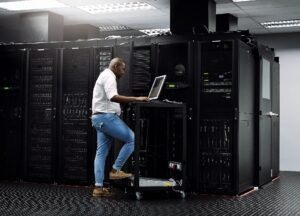Measuring and predicting data center electrical efficiency can be tricky business. As explained in a previous post, a number of variables come into play that make it difficult to paint an accurate picture over time. But painting such a picture is a crucial undertaking in order to wring savings out of your data center electric bill – savings that can be quite substantial.
The solution is to use a mathematical model that represents the workings of a specific data center, and accepts as inputs the IT load, outdoor weather statistics and other variables.
When you measure an actual operating data center, you get data only for the conditions at the time of measurement. But with a model you can provide data for any input conditions fed to it and conduct “what-if” scenarios to make predictions for different circumstances. For example, a model could provide the expected value of the efficiency of a data center at full load, even when the actual IT load is a small fraction of the rated load. Models of two different data centers can be fed the same input conditions, allowing meaningful comparison. You can even create a model before building a data center, to predict its performance in advance and change variables accordingly.
While relying on periodic measurements has limited usefulness in measuring data center efficiency, they are part of an overall strategy that includes initial and ongoing measurements, which have different objectives:
- Initial measurements are used to calibrate the data center efficiency model, establish “as-is” and “should-be” performance, and identify potential efficiency improvement opportunities.
- Ongoing measurements compare against the model to provide alerts of unexpected inefficiencies and to quantify improvements. Ongoing measurements can be made either by periodic sampling or by continuous instrumentation.
Initial measurements
The first time the efficiency of a data center is measured it should be part of an overall efficiency assessment conducted by experts. The assessment typically provides an analysis of the as-built configuration and recommendations regarding efficiency improvement. Data should be collected from enough subsystems to allow the creation of a mathematical efficiency model, which ideally should be one of the deliverables of the assessment. The initial efficiency measurements can also be immediately used to establish benchmark performance.
Ongoing measurements
Ongoing measurements should be made to quantify any efficiency improvements and to provide warnings regarding any loss of efficiency. The model can correct for the effects of IT load and weather and reveal whether any efficiency variations you find are due to these effects or are caused by actual changes in the underlying data center infrastructure.
You can perform ongoing measurements periodically, such as once in summer and once in winter, or install a continuous real-time measurement system.
Typically you don’t need to measure as many systems for ongoing efficiency measurements as you do for the initial measurement – typically about half as many, and identifying which they are should be part of the initial assessment. Focus ongoing measurements on circuits that are most likely to change over time and are the largest contributors to power consumption. This suggests an instrumentation strategy where the ongoing measurement points are monitored by permanently installed power metering, while the additional points needed for initial measurement are measured using portable instruments.
To learn more about models that can help you accurately measure your data center efficiency, download the APC by Schneider Electric white paper, “Electrical Efficiency Measurement for Data Centers.”


